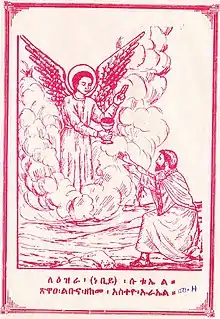Homily on the Archangel Uriel
The Homily on the Archangel Uriel (Ge'ez: ድርሳነ ዑራኤል, romanized: Dǝrsanä ʿUraʾel, lit. 'Homiliary on Uriel' or 'The Sermon of Urael'[1]) is an Ethiopian homiliary containing a collection of miracles and sermons in honour of the Archangel Uriel.

The homiliary itself belongs to a larger collection of homilies dedicated to the angels (Dǝrsanä mälaʾǝkt). It is attested in two Ge'ez manuscripts, namely the earlier 'short' recension (EMML 1835) and the later 'long' recension (EMML 1841), both preserved in the monastic library of Däbrä Ḥayq. The earlier one was copied during the reign of Emperor Zara Yaqob (1434–1468), while the other has been dated to the seventeenth century on palaeographic grounds. The veneration of Uriel seems to have become more popular after Zara Yaqob, the first church in Ethiopia dedicated to him was built by Emperor Na'od (reigned 1494–1508).[2][3]
The Old Testament apocryphal books, 4 Ezra and 1 Enoch (both are considered canonical by the Ethiopian Orthodox Tewahedo Church), serve as the primary base for the homiliary. In general, it depicts Uriel as one of the great archangels, and as the angelus interpres who has interpreted prophecies to Enoch and Ezra, and the helper of both of them.
The homiliary is influential over the Ethiopian Orthodox Tewahedo Church traditions about the Archangel Uriel, it comprises dozens of homilies and miracles attested in more than thirteen manuscripts.[2] The miracle story of A Miracle of the Archangel Uriel Worked for Abba Giyorgis of Gasǝč̣č̣a is taken from the Dǝrsanä ʿUraʾel.[4] According to the Dǝrsanä, at the time of the Crucifixion of Jesus, Uriel dipped his wing in the blood and water flowing from Christ's flank and filled a vessel (cup) with it. Carrying the cup, he fled to Ethiopia and sprinkled the blood on many places to sanctify them for building churches.[5][6] Thus Uriel is often depicted carrying a chalice filled with the blood of Christ in Ethiopian Orthodox iconography.[7][8][9]
References
- Esler, Philip Francis, ed. (9 June 2017). The Blessing of Enoch: 1 Enoch and Contemporary Theology. Eugene, OR: Wipf and Stock Publishers. p. 29. ISBN 9781532614255.
- Tefera, Amsalu; Bausi, Alessandro; Tafla, Bairu; Braukämper, Ulrich; Gerhardt, Ludwig; Meyer-Bahlburg, Hilke; Uhlig, Siegbert (2018). "A Fifteenth-Century Ethiopian Homily on the Archangel Uriel". Aethiopica: International Journal of Ethiopian and Eritrean Studies. 21. ISBN 978-3-447-18045-0. Retrieved 16 June 2019.
- Tefera, Amsalu (2018). "Dating the Homily on Uriel (Dǝrsanä Ura'el)". ices20-mu.org. Retrieved 16 June 2019.
- Haile, Getatchew (2009). "A Miracle of the Archangel Uriel Worked for Abba Giyorgis of Gasǝč̣č̣a" (PDF). portal.svt.ntnu.no. Retrieved 16 June 2019.
- Böll, Verena, ed. (2004). Studia Aethiopica. Wiesbaden: Otto Harrassowitz Verlag. p. 440. ISBN 9783447048910.
- Houlden, James Leslie (2003). Jesus in History, Thought, and Culture: An Encyclopedia, Volume 1. Santa Barbara, California: ABC-CLIO. p. 265. ISBN 9781576078563.
- "Icon of Ourael". www.ethiopianorthodox.org. Retrieved 17 June 2019.
- Wachter, Barbara. "Ethiopia IV". barbarawachter-kitzingen.de. Retrieved 17 June 2019.
- "Kidus Urael". img.youtube.com. 2017. Retrieved 17 June 2019.